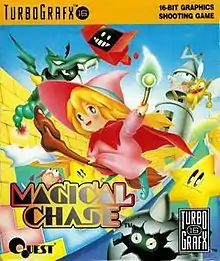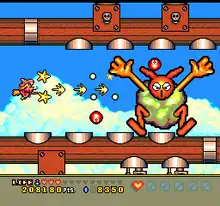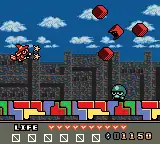Magical Chase
Magical Chase[lower-alpha 1] is a 1991 horizontally scrolling shooter video game developed by Quest and published by Palsoft and Turbo Technologies Inc. for the TurboGrafx-16. The game stars a young witch apprentice named Ripple, who broke a promise to her teacher by accidentally releasing six demons from a forbidden book, joined by her star companions Topsy and Turvy on a quest to catch and seal the demons back into the book.
| Magical Chase | |
|---|---|
 | |
| Developer(s) | Quest |
| Publisher(s) | |
| Designer(s) | Hiroshi Minagawa |
| Artist(s) | Hiroshi Minagawa |
| Composer(s) | Hitoshi Sakimoto Masaharu Iwata |
| Platform(s) | TurboGrafx-16, Microsoft Windows, Game Boy Color |
| Release | TurboGrafx-16Windows
|
| Genre(s) | Horizontally scrolling shooter |
| Mode(s) | Single-player |
Magical Chase was created by most of the same team at Quest that would go to work on Ogre Battle and Final Fantasy Tactics. The game was released in Japan in 1991 amid Palsoft's closure, resulting in a low print run before being re-released by Japanese magazine PC Engine Fan via mail order. It was graphically altered for its late 1993 North American release at the end of the TurboGrafx-16's lifecycle. It is considered by gaming journalists as one of the rarest, most valuable and sought-after TurboGrafx titles.
Magical Chase was met with positive reception from critics since its initial launch; it was praised for its colorful cartoon-like presentation, graphical effects, lack of slowdown, sound and gameplay. Retrospective commentary has been positive, with praise given to the use of parallax scrolling that pushed the TurboGrafx-16 to its limits. It was ported to Microsoft Windows in 1998 and Game Boy Color in 2000.
Gameplay

Magical Chase is a horizontal-scrolling shoot 'em up game similar to Cotton and Gradius.[1][2] The game stars a young witch named Ripple, an apprentice who broke a promise she made to her witch teacher by taking a peek inside a forbidden book and freeing six demons.[3][4] Unless she can catch all six and get them back inside the book, the witch will turn Ripple into a frog. Ripple sets off on her quest with her two elf-star friends known as "Star Maidens": Topsy and Turvy, both of which act as satellite-like options.[4][5]
There are a total of six levels in the game which can be played on easy, normal or hard difficulty settings.[4] Only the first three can be played on the easy difficulty setting.[4] As enemies are destroyed, they leave behind different colored gemstones which serve as the game's currency.[4][5] During each level, a shop appears where power-ups, health, and extra lives can be purchased.[4][5] Touching obstacles and the ground does not kill the player but it does impede progress. If the player gets trapped behind objects at the left-hand side of the screen, "scrolling damage" will occur. Every stage is presented with the name of the mid-boss encountered, and keeping with the magic theme, is titled as a magical seal.[4][5] Each level has a mid-boss and end-boss.[4][5]
Development and release
Magical Chase was developed by most of the same team at Quest that would later go on to work on Ogre Battle and Final Fantasy Tactics.[6][7] Hiroshi Minagawa served as art director and game designer of the project.[7][8] The soundtrack was co-composed by Hitoshi Sakimoto and Masaharu Iwata (under the alias "Rezon"), with Sakimoto being requested by Iwata to work on the project.[7][9][10][11][12] Iwata said that it was a joy composing music for "such a good game", as he did not face struggle with the PC Engine hardware during development, regarding it to be the shooting game he liked the most scoring.[13]

Magical Chase was originally launched for the PC Engine in Japan by Palsoft on November 15, 1991.[14] Prior to release, the game was demonstrated at the 1991 Tokyo Toy Show during summer.[15] Because of Palsoft going bankrupt at the time of its release, the title received a small print run and became a premium item in Japan due to being difficult to find.[16][17] In response to the large demand from consumers, Japanese magazine PC Engine Fan re-released it as a "Fan Edition" via mail order.[4][16][17] The game was initially slated for a November 1992 launch in North America before being published by Turbo Technologies Inc. between April and May of 1993.[1][18][19] The North American release features extensively modified graphics for certain character sprites and the first stage compared to the original Japanese release.[3][4] Its late 1993 release at the end of the TurboGrafx's lifespan in North America, coupled with extensive hype and only being available via mail order, makes the game harder to find and more expensive than earlier releases, becoming a rare collector's item that commands high prices on the secondary game collecting market.[2][20][21][22]
Magical Chase was first ported to Windows 95 by RSP Team and published by Bothtec in Japan on April 10, 1998 and was later re-released as a budget title on January 14, 2000.[14][23] The Windows port is a straight conversion featuring Red Book audio.[4] This port was also included as part of the Bothtec Game Pack 99 compilation.[24] The game was later ported to Game Boy Color and published in Japan by Microcabin on August 4, 2000 under the title Magical Chase GB: Minarai Mahoutsukai Kenja no Tani e.[lower-alpha 2][14] This version faithfully reproduces the parallax scrolling effect, which was characteristic of the PC Engine original, but the visuals and music were simplified due to hardware limitations.[4][25] Because of its inherited popularity and low print run, the GBC version fares high prices on the resale market.[25][26] The intellectual property is currently owned by Square Enix, as per their buyout of Quest in 2002.[11] In 2013, SuperSweep published an album featuring the game's original, arranged and prototype tracks.[4][11][12]
Reception
| Publication | Score |
|---|---|
| AllGame | (TG-16) |
| Consoles + | (TG-16) 97%[28] |
| Electronic Gaming Monthly | (TG-16) 7/10[29] |
| Famitsu | (TG-16) 26/40[30] (GBC) 23/40[31] |
| GamePro | (TG-16) 4.0/5[32] |
| Génération 4 | (TG-16) 88%[33] |
| Joypad | (TG-16) 83%[34] |
| Joystick | (TG-16) 83%[35] |
| VideoGames & Computer Entertainment | (TG-16) 7/10[36] |
| Consolemania | (TG-16) 90/100[37] |
Magical Chase garnered positive reception from critics since its release.[31][32][37] Fan reception was also positive;[38] readers of PC Engine Fan voted to give the game a 26.77 out of 30 score and ranking at the number 3 spot in a poll, indicating a very large popular following.[39]
Famitsu's four reviewers noted that it incorporated elements from R-Type, Super Mario World and Fantasy Zone.[30] El Nionio and Rocket of Consoles + criticized its presentation but commended the detailed visuals, fast parallax scrolling, sound design, playability and longevity.[28] Génération 4's Philippe Querleux highly praised the audiovisual presentation, animations and playability.[33] Likewise, Joypad's Jean-Marc Demoly and Joystick's Sébastien Hamon commended the animated visuals, sound and controls.[34][35]
Electronic Gaming Monthly's four reviewers gave positive remarks to its premise, solid gameplay, music, bizarre enemy designs and cutesy cartoon-like visuals.[29] VideoGames & Computer Entertainment's Josh Mandel compared its visual style with Air Zonk, giving positive remarks to its simplicity and ambitious graphical effects, lack of slowdown and adequate difficulty.[36] AllGame's Shawn Sackenheim praised Magical Chase's colorful cartoon-esque visual presentation, comparing its wacky character designs with Parodius, lack of slowdown, sound design, moderate challenge and gameplay but criticized its short length.[27]
Retrospective commentary has been equally positive.[40] Retro Gamer's Damien McFerran regarded the TurboGrafx-16 original as one of the system's "perfect ten" games, stating that it is a solid shoot 'em up title past the cute visuals.[3] IGN's Lucas M. Thomas placed both Magical Chase and Cotton: Fantastic Night Dreams as number four on the top ten list of TurboGrafx titles not released on the Virtual Console, stating that both games were different but shared the same general idea.[41] Hardcore Gamer's Michael Thomasson praised the game's use of parallax scrolling as a technical feat for the TurboGrafx-16.[2] USgamer's Jeremy Parish regarded it as a "shameless clone" of Cotton due to being released in a similar time frame but noted that its protagonist Ripple looks similar to the witch class in the Ogre Battle series.[42] The Japanese book PC Engine Complete Guide 1987-1999 praised the original TurboGrafx-16 release for its carefully hand-drawn characters and backgrounds, use of parallax scrolling that pushed the system to its limits and music.[16]
Notes
References
- "Special Feature! - The Turbo Tech Lineup". GamePro. No. 38. IDG. September 1992. pp. 105–107.
- Thomasson, Michael (December 2008). "Feature: Let's RetroGamer Holiday". Hardcore Gamer. Vol. 4, no. 4. Prima Games. pp. 34–41.
- McFerran, Damien (May 22, 2008). "Retroinspection: PC-Engine GT". Retro Gamer. No. 51. Imagine Publishing. pp. 62–69.
- Kalata, Kurt (February 26, 2016). "Magical Chase". Hardcore Gaming 101. Archived from the original on 2016-02-29. Retrieved 2021-03-11.
- Magical Chase manual (TurboGrafx-16, US)
- Loe, Casey (October 1996). "Gen-32 Japan Soft: Final Fantasy Tactics". GameFan. Vol. 4, no. 10. Metropolis Media. p. 111.
- Sakimoto, Hitoshi; Winkler, Chris. "RPGFan Exclusive Interview #4: Hitoshi Sakimoto, composer, Basiscape". RPGFan. Archived from the original on February 18, 2010. Retrieved 2021-09-07.
- "Vagrant Story: from the Development Team". Square. 2000. Archived from the original on 2002-08-08. Retrieved 2021-03-11.
- Greening, Chris (July 4, 2008). "Hitoshi Sakimoto :: Biography". Square Enix Music Online. Archived from the original on 2010-07-12. Retrieved 2021-02-11.
- Kermarrec, Jérémie; Jeriaska (September 15, 2008). "Interview with Masaharu Iwata". RPGFan. Archived from the original on December 30, 2009. Retrieved 2021-09-07.
- "STG「VECTROS」「マジカルチェイス」のサウンドトラックCDが2月26日に発売". 4Gamer.net (in Japanese). Aetas Inc. February 2, 2013. Archived from the original on 2016-10-30. Retrieved 2021-03-10.
- Napolitano, Jayson (March 20, 2013). "Magical Chase soundtrack is finally something you can own - Early music by Hitoshi Sakimoto and Masaharu Iwata". Destructoid. Enthusiast Gaming. Archived from the original on 2015-09-06. Retrieved 2021-03-10.
- GERTRACK! (17 October 2010). "Geki On! > Shooting Game Music & Shooting Game Video ARCHIVE: 【ゲーム音楽】 ベイシスケイプ作曲家インタビュー". Shooting Gameside (in Japanese). Vol. 1. Micro Magazine. pp. 88–95. ISBN 978-4896373486. (Translation by Shmuplations. Archived 2019-09-14 at the Wayback Machine).
- "魔女っ子シューティング". Shooting Gameside (in Japanese). Vol. 3. Micro Magazine. 24 September 2011. pp. 81–98. ISBN 978-4896373714.
- Nauert, Donn (September 1991). "Tokyo Toy Show — Summer 1991". TurboPlay. No. 8. Larry Flynt Publications. pp. 24–29.
- "PCエンジンソフト完全カタログ 1993年 - マジカルチェイス". PC Engine Complete Guide 1987-1999. Nostalgic Game Console Encyclopedia (in Japanese). Vol. 1. Standards. June 15, 2018. p. 114. ISBN 9784866362670.
- Mori, Atsushi (April 3, 2018). "価格は24万円! 幻のPCエンジン向けゲーム「マジカルチェイス」が入荷、しかも未開封品". AKIBA PC Hotline! (in Japanese). Impress Corporation. Archived from the original on 2020-10-26. Retrieved 2021-03-10.
- "Fact-Files - Duo: Broom Totin' Witch! - Magical Chase". Electronic Gaming Monthly. No. 45. Sendai Publishing. April 1993. p. 140.
- "TurboPreviews - Duo Data: Magical Chase". TurboForce. No. 4. Sendai Publishing. April 1993. p. 14.
- Massey, Tom (January 25, 2015). "A guide to gaming's most valuable treasures". Eurogamer. Gamer Network. Archived from the original on 2017-11-12. Retrieved 2021-03-11.
- Hashimoto, Shingi (March 30, 2015). "秋葉原にレトロPC&ゲーム店『BEEP@秋葉原』オープン。レトロゲーム関連基板や雑誌、グッズなどまで扱う総合店、海外ハードや名作試遊コーナーも". Engadget (in Japanese). AOL. Archived from the original on 2015-11-05. Retrieved 2021-03-10.
- Reichert, Nick (July 24, 2018). "The Rarest & Most Valuable PC Engine/TurboGrafx-16 Games". Racketboy. Archived from the original on 2018-10-05. Retrieved 2021-03-11.
- "ボーステックが低価格でPCタイトル提供「BOTHTEC HAPPY PRICE シリーズ」発売". SoftBank Games (in Japanese). ITmedia. December 14, 1999. Archived from the original on 2020-02-16. Retrieved 2021-03-11.
- "ボーステックゲームパック99 の最新ニュースやレビュー". Gamer (in Japanese). ixll Co., Ltd. 2021. Archived from the original on 2013-04-24. Retrieved 2021-03-11.
- "マジカルチェイス" [Magical Chase]. 懐かしゲームボーイパーフェクトガイド [Perfect Guide of Nostalgic Game Boy]. Perfect Guide (in Japanese). Magazine Box. February 25, 2017. p. 50. ISBN 9784866400259.
- Reichert, Nick (August 15, 2019). "The Rarest & Most Valuable Gameboy Color Games". Racketboy. Archived from the original on 2020-10-20. Retrieved 2021-03-11.
- Sackenheim, Shawn (1998). "Magical Chase (turboGrafx-16) - Review". AllGame. All Media Network. Archived from the original on 2014-11-16. Retrieved 2021-03-10.
- El Nionio; Rocket (January 1992). "PC Engine Review: Magical Chase". Consoles + (in French). No. 5. M.E.R.7. pp. 42–43. Archived from the original on 2017-09-08. Retrieved 2021-03-10.
- Harris, Steve; Semrad, Ed; Alessi, Martin; Williams, Ken (May 1993). "Review Crew – Duo / Hudson/T.T.I.: Magical Chase". Electronic Gaming Monthly. No. 46. Sendai Publishing. p. 32.
- "NEW GAMES CROSS REVIEW: マジカルチェイス". Famitsu (in Japanese). No. 153. ASCII Corporation. November 22, 1991. Archived from the original on 2016-10-29. Retrieved 2021-03-10.
- "NEW GAMES CROSS REVIEW: マジカルチェイスGB 〜見習い魔法使い 賢者の谷へ〜". Famitsu (in Japanese). No. 608. Enterbrain. August 2000. Archived from the original on 2018-07-22. Retrieved 2021-03-10.
- Oss, Kay (June 1993). "TurboChip ProReview: Magical Chase". GamePro. No. 47. IDG. p. 118.
- Querleux, Philippe (January 1992). "Console Test: Magical Chase (Coregrafx)". Génération 4 (in French). No. 40. Computec Media France. p. 143.
- Demoly, Jean-Marc; Hamon, Sébastien (January 1992). "NEC | Tests: Enfourchez donc ce balai qui s'ennuie depuis trop longtemps - Magical Chase". Joypad (in French). No. 24. Yellow Media. pp. 110–111.
- Hamon, Sébastien (January 1992). "Console News: PC Engine - Magical Chase". Joystick (in French). No. 15. Sipress. p. 155.
- Mandel, Josh (May 1993). "Video-Game Reviews - Magical Chase (TTI) For the TurboGrafx-16/Turbo Duo". VideoGames & Computer Entertainment. No. 52. Larry Flynt Publications. p. 54.
- Calzetta, Giancarlo (January 1992). "Magical Chase (PC Engine)". Consolemania (in Italian). No. 4. Xenia Edizioni. pp. 68–69.
- "CVG Charts - PC Engine". Computer and Video Games. No. 122. EMAP. January 1992. p. 88.
- "PC Engine All Catalog '93 10月号特別付録 - マジカルチェイス". PC Engine Fan (in Japanese). Vol. 6, no. 10. Tokuma Shoten. 1 October 1993. p. 93.
- Laurie, Malcolm (2007). "MAGICAL CHASE - PALSOFT/QUEST - PC ENGINE". SHMUPS!. GameSpy. Archived from the original on 2009-04-18. Retrieved 2021-03-10.
- Thomas, Lucas M. (17 October 2008). "Retro Remix: Top 10 Unreleased TurboGrafx Titles - Our Virtual Console countdown continues, as we take a look at the top ten titles from Hudson's two Turbos". IGN. Ziff Davis. Archived from the original on 2016-08-20. Retrieved 2021-03-10.
- Parish, Jeremy (February 5, 2014). "Daily Classic: With Cotton, TG-16 Shooters Got Adorable - Success' whimsical arcade shooter was like the meet cute of shooters and anime". USgamer. Gamer Network. Archived from the original on 2016-10-08. Retrieved 2021-03-10.
External links
- Official website (Windows) (in Japanese)
- Official website (GBC) (in Japanese)